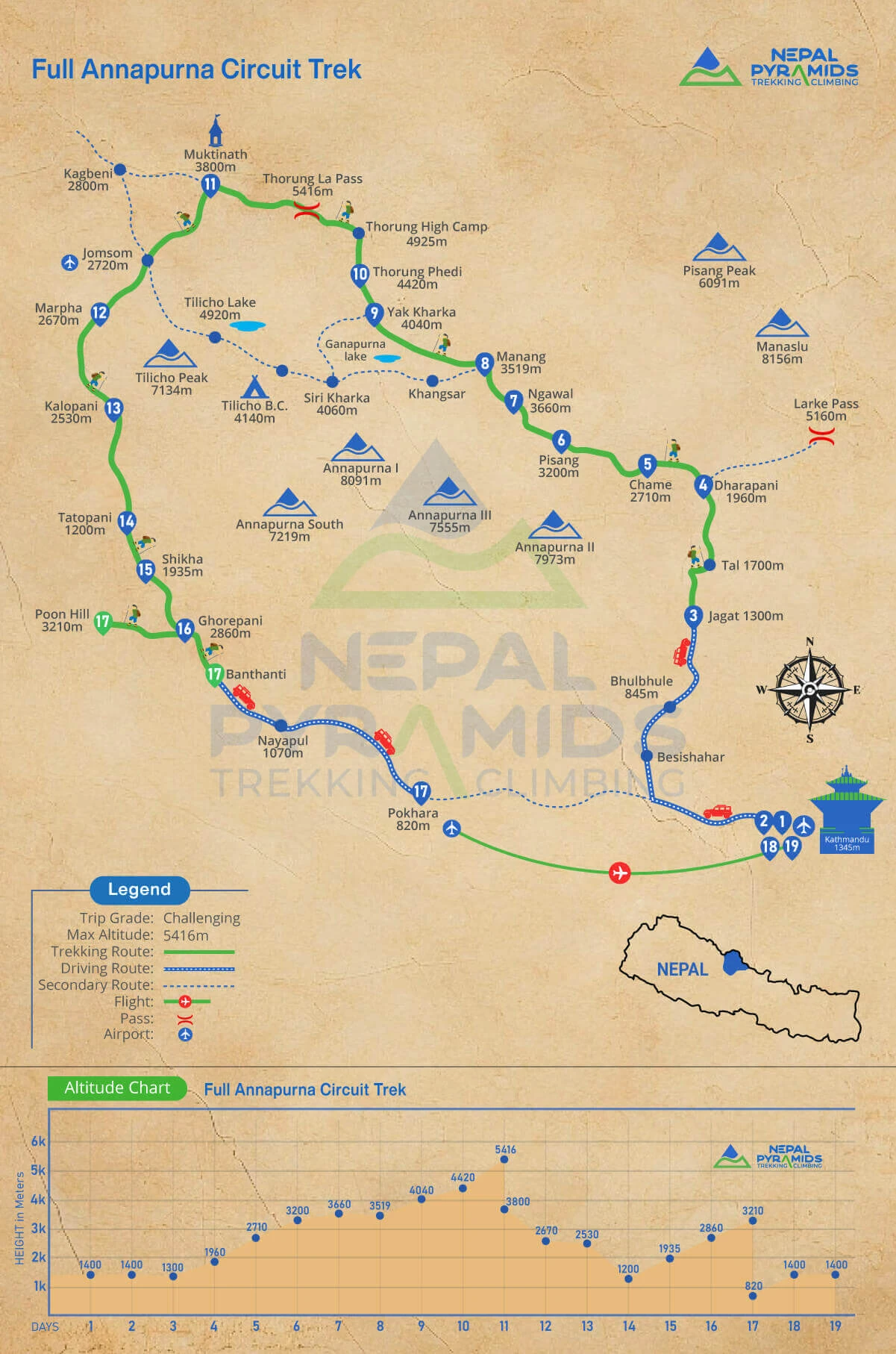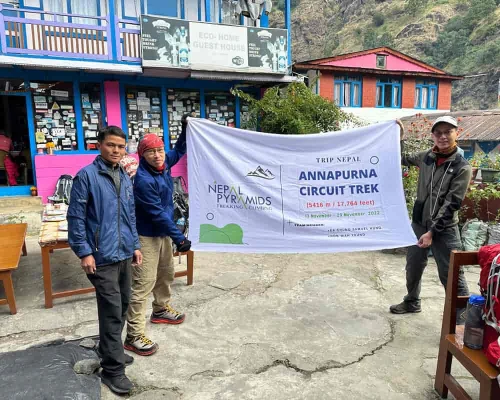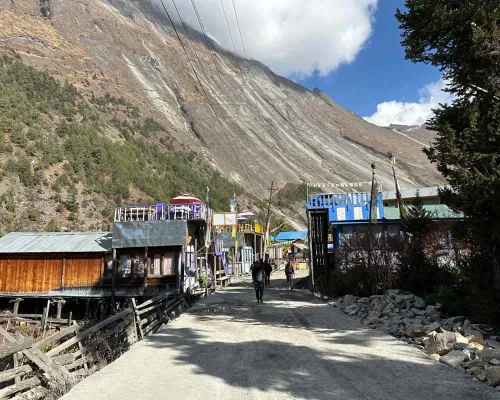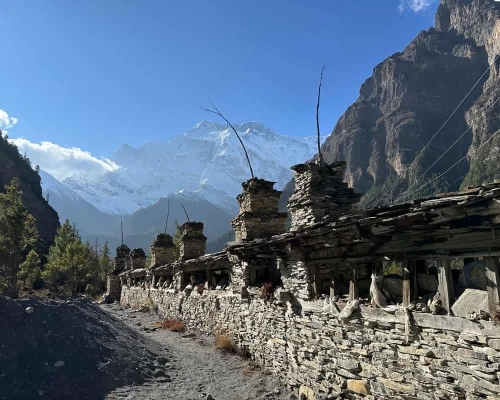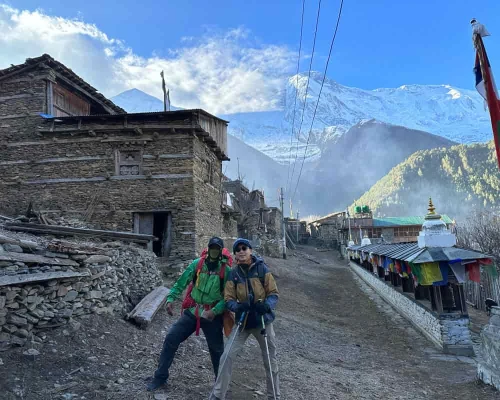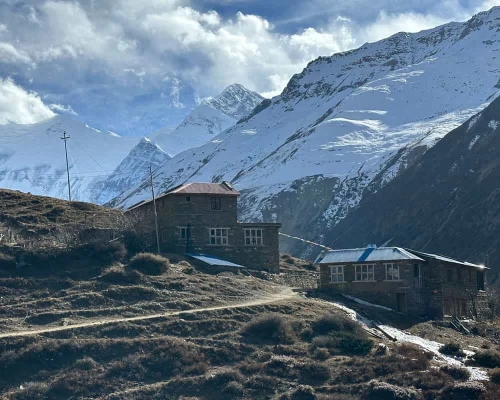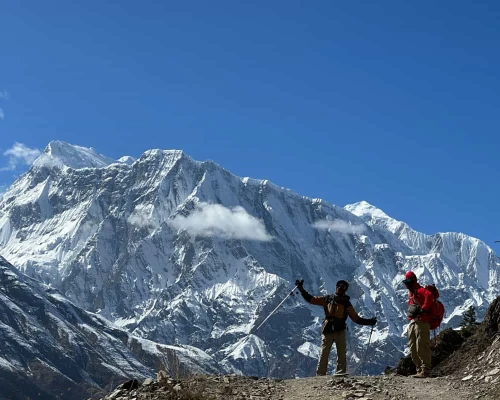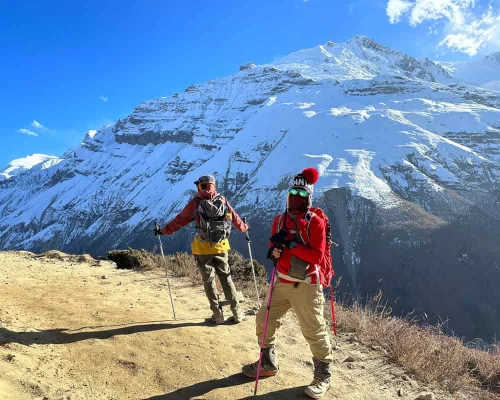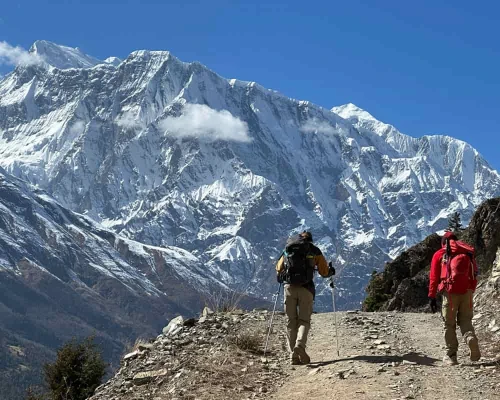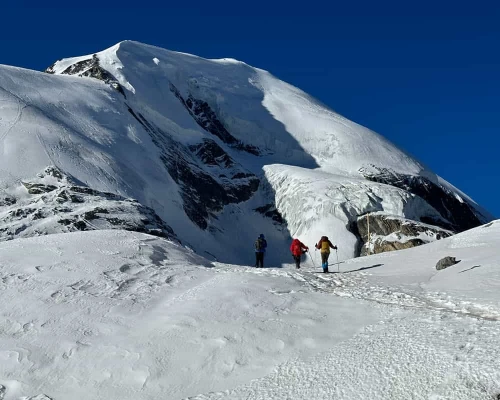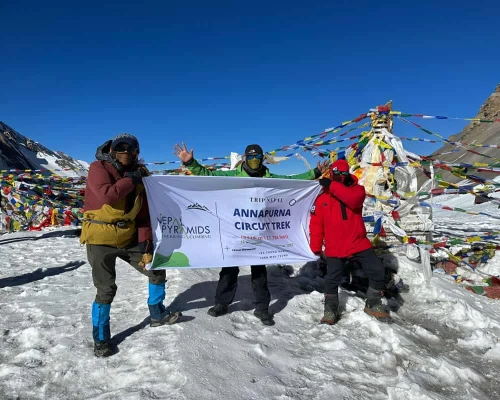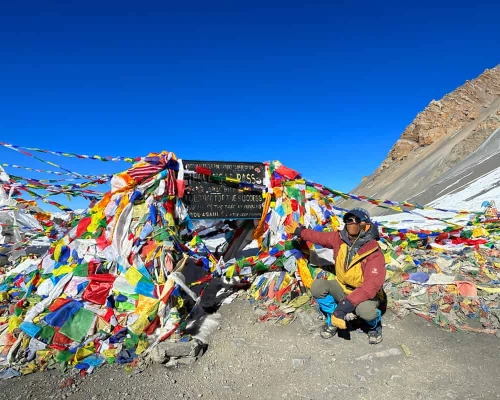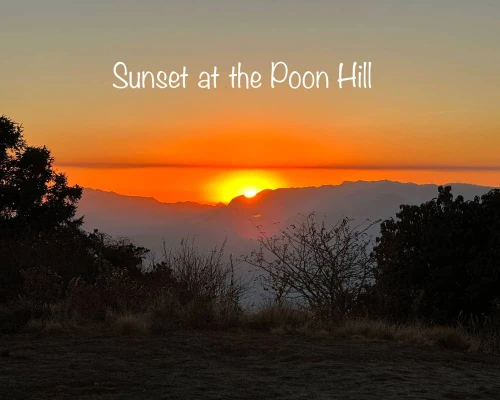The Full Annapurna Circuit Trek Highlights and Attractions:
- Trek through the remarkable, mystical valley of the Marshyangdi River with miraculous terrain settings.
- Staying at traditional settlements and enjoying the organic food variety.
- The miraculous view of the Annapurna massif and numerous other prominent peaks.
- Witness the amazing transformation of the valleys, terrain, and views as you go higher into these hidden valleys.
- Going over Thorang La (5,416 m/17,764 ft), the world’s highest navigable pass, gives you a great sense of accomplishment.
- Visit Muktinath, a very sacred place for both Hindus and Buddhists.
- Walking through Nepal’s windy valley of Jomsom.
- Overnight at the most picturesque village of Marpha, also known as the Apple Valley.
- Walk into the Kali Gandaki Valley, the deepest gorge in the world.
- Relax at Tatopani, the Natural hot spring.
- Overnight at Ghorepani, the crucial junction during the Salt Trade Era.
- Walk to POON HILL for the most phenomenal sunrise view.
- Explore Pokhara (820 m), the second biggest city and the second home of tourists.
No wonder The Full Annapurna Circuit Trek was once the world's No. 1 trekking destination.
Full Annapurna Circuit Trek (ACT) Overview:
This extended epic trek used to be once the world’s no. 1 trekking destination. The Full Annapurna Circuit Trek is by far the most admired and beautiful trekking destination of all. It is indeed a long and challenging trek that covers a significant distance. This trip is intended for those who fancy doing the entire ACT walking.
However, these days, many trekkers, both national and international, rely on transportation to cover the distance in a short period. With the building of the roadway on both sides of the Thorong La Pass, this extended trek has been shortened and has become easily accessible.
But still, many trekkers prefer to do the Full Annapurna Circuit Trek walking without relying on any means of transportation. As of now, this has become a trend to finish the Full ACT in a traditional way.
This extended classical trek is renowned for its stunning scenery, diverse landscapes, and cultural experiences. If you are seeking to finish the historic Annapurna Circuit route in a traditional style, then the Full Annapurna Circuit Trek is an appropriate choice.
As said, due to road construction in the area, the Annapurna Circuit trek has changed in recent years. A road has been constructed as far as Manang and as far as Poon Hill on the other side. The roadway has made it very easily accessible by vehicles. As a result, some trekkers choose to use transportation for certain sections of the trek to save time or customize their itinerary.
But the construction of roadways has NOT taken away the charm of the Annapurna Circuit. It is still very fascinating and still lures thousands of tourists every year. On the other hand, there are a number of travelers who still fancy walking the full circuit without any ground transportation aid.
Nonetheless, the Annapurna Circuit trek still has that authentic charm and continues to provide a true trekking experience. The section from Manang to Thorong La Pass, and descending towards Muktinath, is still untouched by these constructions. It allows trekkers to experience the natural beauty and serenity of the trekking trails.
Full ACT (Annapurna Circuit Trek) Trip Profile:
Like the Everest Base Camp Trek or Annapurna Base Camp Trek full ACT is not a one-way trek. It starts from Marshyangdi Valley and cruises through diverse landscapes, taking you to the most dramatic landscape setting in a different Kali Gandaki Valley.
The full Annapurna Circuit Trek starts with a scenic drive to the traditional village of Dharapani. The drive may be long, but as you drive, you will witness the changes in landscapes, the famous terraced fields, the countryside's rustic life, mountain views, and deep valleys. We will stay overnight in the beautiful village of Dharpani.
Following the gorgeous Marshyangdi Valley, we will walk to the ancient settlement of Chame. As we walk to Chame, we will have lunch at a beautiful settlement of Tal (lake). Tal is named as it is believed that it was once a lake before people started settling there. Now, from Tal, we will enter into a different district of Manang. If the weather is clear, you will see the snow-capped mountains of Annapurna II and Himalchuli.
Leaving Chame, we will walk a broader trail leading us to the settlement of Khampas, the Tibetan warriors. Gradually, we will leave the treeline behind and now slowly enter the alpine area of Pisang. We will trek higher up to Upper Pisang for an overnight stay, from where the view is phenomenal.
From Pisang, we will walk the vertical trail that will lead us to the vantage point of Ghyaru. We will spend some time here to take nature deep within our thoughts and to enjoy the most stunning view of the Annapurna Massif, including the Manaslu, the eighth-highest mountain in the world. Finally, we will stay overnight at the ancient town of Ngawal at 3660 meters.
The view from Ngawal village is equally stunning. From Nagwal, we will descend to another paradise-like town of Manang. Leaving Manang, we will now enter the terrain of the Himalayan meadow, where the view of the Chulu range is remarkable. We will spend a night in an isolated, small area of Yak Kharka.
From Yak Kharka, we will now head towards Thorong Phedi (base camp). We will cross the challenging Thorong La, which is 5,416 meters high. Soon, we cross this iconic mountain Pass, we will enter a different valley of Kali Gandaki into a different district of Mustang. Here, the landscapes will be completely different from what we have been seeing till now. Mustang is a desert in Nepal.
Overnight at the most sacred town of Muktinath is something very spiritual. Shortly, the next day, following the prehistoric Kali Gandaki Gorge, we will walk to Jomsom, the Windy Valley of Nepal. Leaving Jomsom, we will further walk to our night destination of Marpha, the Apple Valley. Marpha, also known as White Village, displays ancient town architecture with narrow gullies and stone-built houses like in Tibet.
We will now leave the alpine and desert landscapes and gradually enter into tropical with more lush forested areas. Walking the Orange Valley, we will eventually reach Tatopani, the Natural Hot Spring , where we will relax our tired muscles. Leaving the hot spring, we will steeply ascend to Ghorepani and the next day climb Poon Hill for the most fascinating view. Our trip concludes with a scenic flight from Pokhara to Kathmandu.
A few facts about the Full Annapurna Circuit Trail:
Beauty:
This Full Annapurna Circuit trek is certainly very beautiful among the many trekking destinations of Nepal. This ancient route once served as a fundamental salt trading route between Nepal and Tibet. The diverse topographic settings that this trek has to offer are not found elsewhere. The unique culture, varied ethnicity, diverse terrain, beautiful traditional settlements, and the scenic beauty are heavenly.
Annapurna circuit, which is approximately 248 km/154 miles in total length, comprises five different districts of Nepal, namely Lamjung, Manang, Mustang, Myagdi, and Kaski.
You start from the subtropical area of Lamjung to the high alpine region of Manang. Furthermore, you experience the desert of Mustang and get back to the subtropical area of Myagdi and Kaski.
All these demonstrate the unique diversity of the Full Annapurna Circuit Trek, making it one of the most sought-after trekking destinations of Nepal. As you trek the region, you will be amazed by the everyday shifting transformation in the vegetation and landscape, which is magical.
Early Exploration and Development:
Though the Annapurna route was a crucial route during the Salt Trade Era between Nepal and Tibet, it remained isolated from the outside world till 1950. The area was opened to foreign visitors only in 1950, during which time the French Annapurna Expedition led by Maurice Herzog, along with Louis Lachenal, climbed Annapurna I (one).
Annapurna I, the world's 10th-highest mountain, was climbed before Mount Everest, which was indeed the first human ascent to 8000 meters. The first ascent of Annapurna I was on June 3, 1950, and it is considered one of the most historic achievements in the history of mountaineering.
The development of the Annapurna Circuit Trail began in the early 1970s. This was when the Nepalese government, in collaboration with various international organizations, started constructing trails and teahouse lodges along the route. The goal was to promote trekking and tourism in the region.
In the 1970s and 1980s, the Annapurna Circuit Trail gained popularity among trekkers and adventurers from around the world. Due to its variation and diversity, it became the 'World’s Number ONE Trekking Destination'.
Changes in ACT over the years:
In the past, the Annapurna Circuit Route was a complete circuit that started in Besisahar and, via the challenging Thorong La Pass, ended in Nayapul. However, with the construction of the Jomsom Airport, the Full Annapurna Circuit length became shorter. Many trekkers with limited time started flying to Pokhara from Jomsom Airport without completing the full circuit.
Furthermore, the road construction in the region has now led to a drastic change in the Annapurna Circuit duration. With this development, many trekkers began doing the Annapurna Circuit, skipping sections of the trail and completing it within a short period of time.
The Impact of the Road Construction:
The construction of the road along the Annapurna Circuit Trail has brought both positive and negative consequences. On the positive side, it has improved accessibility for local communities, enabling easier transportation of goods and services.
However, on the other hand, it has also affected the overall trekking experience. Many believe that this has dramatically changed the genuine Annapurna Circuit Trek experience. As of now, it is said that 75% of the trekking route has been impacted by roadway construction that's trying to connect every village in the region.
What was once trekking into wilderness trails has now transformed into a roadway where trekkers walk alongside jeeps and buses on dusty roads. Most trekkers have termed it as an unpleasant experience, though the beauty of ACT is still pristine.
Furthermore, the roads have also brought environmental concerns, including pollution, wildlife impact, deforestation, and exploitation of natural resources.
Still, the Annapurna Circuit Trail continues to attract trekkers from all over the world. Though the construction of the roadway has impacted trekking over the years, it still delivers real natural beauty and cultural heritage of the Annapurna region in Nepal.
“It is a shame for a man to grow old without seeing the beauty and strength of which his body is capable.”
Come over and join us to experience the mystical lands of Nepal.
If you are looking for a shorter version of the Annapurna Circuit Trek, you can do a 14-day ACT Trek.
Or you can add Tilicho Lake, the world's highest glacial lake with Annapurna Circuit Trek. If you have enough time to explore the entire Annapurna region, you can also combine the Annapurna Circuit with the Annapurna Base Camp Trek.


